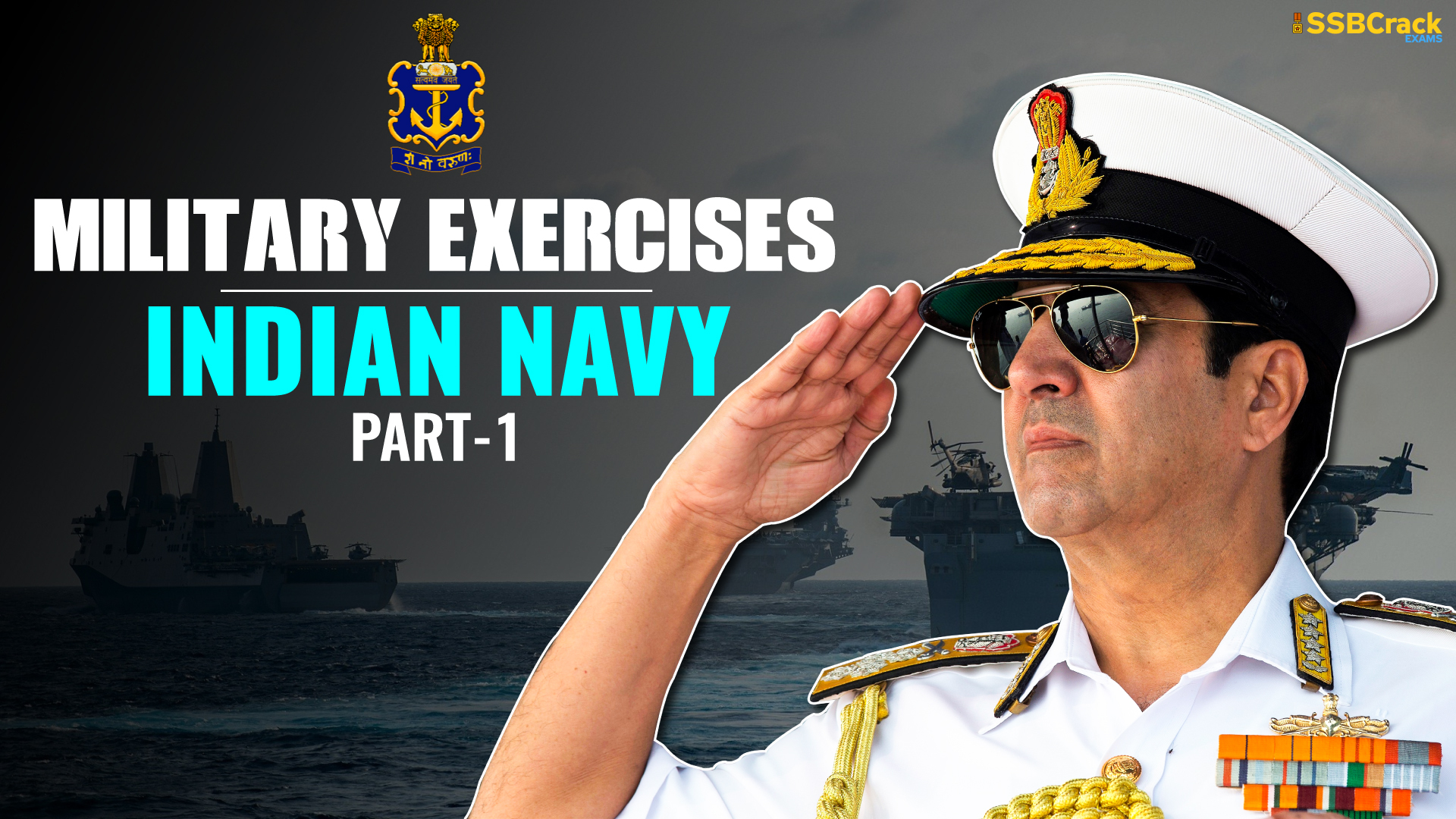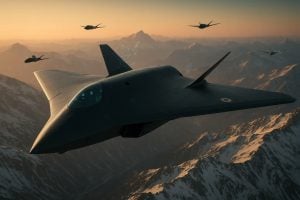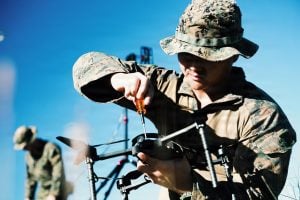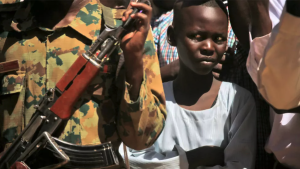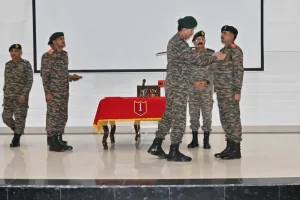Important Military Exercises Participated By Indian Navy


1. Malabar – 20 Phase 1
| 1. | Participating navies | Indian Navy, Japan Maritime Self-Defence Force, United States Navy, Her Majesty’s Royal Australian Navy |
| 2. | Dates of the exercise | Phase 1: 03-Nov-2020 to 06-Nov-2020 (4 days) Phase 2: 17-Nov-2020 to 20-Nov-2020 (4 days) |
| 3. | Place where exercise was conducted | Phase 1: Visakhapatnam, Bay of Bengal Phase 2: Northern Arabian Sea |
| 4. | Indian units that have participated in the Phase 1 | INS Ranvijay (Destroyer), INS Shivalik (Frigate), INS Sukanya (Off Shore Patrol Vessel), INS Shakti (Fleet Support Ship), INS Sindhuraj (Sindhughosh-class submarine)Advanced Jet Trainer Hawk, Long-range maritime patrol aircraft P-8I, Dornier maritime patrol aircraft,Various helicopters |
| 5. | Foreign Ships & aircraft participated in the Phase 1 | USS John S McCain (Guided-missile destroyer), HMAS Ballarat (long range frigate) with integral MH-60 helicopter,JMSDF Onami (Destroyer) with integral SH-60 helicopter |
| 6. | Indian units that have participated in the Phase 2 | INS Vikramaditya (Aircraft Carrier) with integral MiG-29K fighters & helicoptersINS Kolkata (Stealth guided-missile destroyer)INS Chennai (Kolkata-class stealth destroyer)INS Talwar (Talwar-class stealth frigate)INS Deepak (fleet support ship)INS Khanderi (Kalvari-class submarine)P8I maritime reconnaissance aircrafts |
| 7. | Foreign Ships & aircraft participated in the Phase 2 | USS Nimitz (Aircraft Carrier) with integral F-18 & E2C Hawkeye Fighter aircraftUSS Princeton (Ticonderoga-class cruiser)USS Sterett (Arleigh Burke-class destroyer)HMAS Ballarat (Anzac-class frigate)JMSDF Onami (Destroyer) |
| 8. | Important Points to remember | MALABAR series of maritime exercises commenced in 1992 as a bilateral IN-USN exercise. Japan Maritime Self-Defence Force joined MALABAR in 2015. The 2020 (24th) edition has witnessed participation of the Royal Australian Navy in this joint maritime exercise.The exercise, being conducted as a ‘non-contact, at sea only’ exercise in view of COVID-19 pandemic. |
| 9. | Goal of the exercise | Commitment to an open, inclusive Indo-Pacific and a rules-based international order.Shared values of trust and mutual defence interest. |
2. SLINEX 2020 (Sri Lanka & India Naval Exercise)
| 1. | Participating navies | Indian Navy, Sri Lankan Navy |
| 2. | Dates of the exercise | 19-Oct-2020 to 21-Oct-2020 (3 days) |
| 3. | Place where exercise was conducted | Trincomalee, Sri Lanka |
| 4. | Indian Ships & aircraft participated | INS Kamorta, an Anti-Submarine Warfare CorvetteINS Kiltan, an Anti-Submarine Warfare CorvetteAdvanced Light Helicopter (ALH) Chetak helicopters Dornier Maritime Patrol aircrafts |
| 5. | Foreign Ships & aircraft participated | SLN Sayura (Offshore Patrol Vessel) SLN Gajabahu (Training Ship) |
| 6. | Important Points to remember | SLINEX series of bilateral maritime exercises were initiated in 2005. This is the 8th edition.The 7th edition of SLINEX was conducted off Visakhapatnam in September 2019.Surface and anti-air exercises including weapon firing, seamanship evolutions, manoeuvres and cross deck flying operations are conducted during the exercise.The exercise is being conducted in a non-contact ‘at-sea-only’ format due to Covid-19 pandemic. |
| 7. | Goal of the exercise | The exercise plays a significant role in strengthening bilateral ties and also reiterating India’s policy of ‘Neighbourhood First’ and‘Security and Growth for all in the Region (SAGAR)’. |
3. Exercise Bongosagar & IN-BN CORPAT
| 1. | Participating navies | Indian Navy, Bangladesh Navy |
| 2. | Dates of the exercise | 03-Oct-2020 – Bongosagar; 04-Oct-2020 to 05-Oct-2020 – CORPAT (3 days) |
| 3. | Place where exercise was conducted | Northern Bay of Bengal |
| 4. | Indian Ships & aircraft participated | INS Kiltan (Anti-Submarine Warfare Corvette)INS Khukri (Guided-Missile Corvette)Maritime patrol aircraft & integral helicopters |
| 5. | Foreign Ships & aircraft participated | BNS Abu Bakr, a Guided-Missile Frigate BNS Prottoy, a Guided-Missile CorvetteMaritime patrol aircraft and integral helicopters |
| 6. | Important Points to remember | This (2nd) edition of Exercise assumes greater significance since it is being conducted during Mujib Barsho, the 100th birth anniversary of Bangabandhu Sheikh Mujibur Rahman.IN and BN units undertook joint patrolling along the International Maritime Boundary Line (IMBL). |
| 7. | Goal of the exercise | Reflecting the priority that Indian Navy accords to Bangladesh Navy as part of Prime Minister Narendra Modi’s vision of SAGAR (Security and Growth for All in the Region). |
4. JIMEX – 20 (Japan India Maritime Exercise)
| 1. | Participating navies | Indian Navy, Japan Maritime Self-Defence Force |
| 2. | Dates of the exercise | 26-Sep-2020 to 28-Sep-2020 (3 days) |
| 3. | Place where exercise was conducted | North Arabian Sea |
| 4. | Indian Ships & aircraft participated | INS Chennai (Indigenously built Stealth Destroyer)INS Tarkash (Teg-class Stealth Frigate)INS Deepak (Fleet Tanker)Maritime patrol aircraft & integral helicopters |
| 5. | Foreign Ships & aircraft participated | JMSDF Kaga (Izumo Class Helicopter Destroyer) JMSDF Ikazuchi (Guided Missile Destroyer)Maritime patrol aircraft & integral helicopters |
| 6. | Important Points to remember | JIMEX series of exercises commenced in January 2012 with special focus on maritime security cooperation. The last edition of JIMEX was conducted in October 2018 off Visakhapatnam, India.JIMEX will be conducted once in every two years.This edition is a “non-contact at sea only” exercise. |
| 7. | Goal of the exercise | Enhance the cooperation and mutual confidence between the two navies and fortify the long-standing bond of friendship between the two countries. |
5. Exercise Naseem-Al-Bahr (Or Sea Breeze)
| 1. | Participating navies | Indian Navy, Royal Navy of Oman |
| 2. | Dates of the exercise | 05-Jan-2020 (1 day) |
| 3. | Place where exercise was conducted | Mormugao Port, Goa |
| 4. | Indian Ships & aircraft participated | INS Beas (Brahmaputra-class frigate)INS Subhadra (Sukanya class patrol vessel)Maritime patrol aircraft & integral helicopters |
| 5. | Foreign Ships & aircraft participated | Royal Navy of Oman (RNO) ship RNOV Al Rasikh RNOV Khassab |
| 6. | Important Points to remember | The exercise is being conducted since 1993.The exercise will have two phases namely the harbour phase in Goa followed by sea phase off the Goa coast.During the harbour phase, the countries will conduct subject matter expert exchanges on professional topics. On the other hand, sea phase will have reciprocal receptions and planning conferences. |
| 7. | Goal of the exercise | Increase interoperability amongst the two navies and develop common understanding and procedures for maritime security operations. |
6. INDRA – 2019
| 1. | Participating navies | Indian tri-services, Russian tri-services |
| 2. | Dates of the exercise | 10-Dec-2019 to 19-Dec-2019 (10 days) |
| 3. | Place where exercise was conducted | Land Based Exercises in Babina, Uttar Pradesh,Naval Operations in Goa,Air Operations in outskirts of Pune, Maharashtra |
| 4. | Indian Ships & aircraft participated | INS Tarkash (Teg-class Stealth Frigate)INS Aditya (Replenishment and repair ship)4 MiG-29 fighter aircraftMaritime patrol aircraft & integral helicopters |
| 5. | Foreign Ships & aircraft participated | RuFN Ship Yaroslav Mudry, RuFN Ship Viktor Konetsky RuFN Ship Elyna |
| 6. | Important Points to remember | INDRA initially began as a bilateral naval exercise between the Indian and the Russian Federation navies in 2003.Other activities conducted as a part of the Harbour Phase of the exercise included Joint Operations Planning, Communication Trials, Professional Lectures and friendly Football, Basketball and Volleyball matches between IN and RuFN personnel. |
| 7. | Goal of the exercise | Increase interoperability amongst the two forces and develop common understanding and procedures for global security operations. |
7. Exercise Za’ir-Al-Bahr (Roar of The Sea)
| 1. | Participating navies | Indian Navy, Qatari Emiri Navy |
| 2. | Dates of the exercise | 17-Nov-2019 to 21-Nov-2019 (5 days) Harbour phase is 3 days and Sea phase is 2 days. |
| 3. | Place where exercise was conducted | Doha, Qatar |
| 4. | Indian Ships & aircraft participated | INS Trikand (Guided Missile Stealth Frigate)P-8I Maritime patrol aircraft |
| 5. | Foreign Ships & aircraft participated | Barzan Class Fast Attack Craft equipped with Anti-Ship MissileRafale multi-task fighter aircraft. |
| 6. | Important Points to remember | This is the inaugural edition of the Bilateral Maritime Exercise between the two navies.The Exercise will include a three-day Harbour Phase and Two days Sea Phase. The Sea Phase will include a Tactical Maritime Exercise involving the domains of Surface Action, Air Defence, Maritime Surveillance and Interdiction Operation and anti-terrorism. |
| 7. | Goal of the exercise | Strengthen the robust defence co-operation between the two countries, especially in the fight against terrorism, maritime piracy and maritime security. |
8. Exercise Samudra Shakti
| 1. | Participating navies | Indian Navy, Indonesian Navy |
| 2. | Dates of the exercise | 06-Nov-2019 to 07-Nov-2019 (2 days) |
| 3. | Place where exercise was conducted | Visakhapatnam, Bay of Bengal |
| 4. | Indian Ships & aircraft participated | INS Kamorta, an Anti-Submarine Warfare Corvette |
| 5. | Foreign Ships & aircraft participated | KRI Usman Harun, a multi-role Corvette. |
| 6. | Important Points to remember | KRI Usman Harun arrived Visakhapatnam on 04 November 2019 to participate in the second edition Ex ‘Samudra Shakti’.The joint exercises included manoeuvres, Surface Warfare exercises, Air Defence exercises, Weapon firing drills, Helicopter Operations and Boarding Operations. |
| 7. | Goal of the exercise | Strengthen the robust defence co-operation between the two countries. |
9. Indo-Thai CORPAT – 2019
| 1. | Participating navies | Indian Navy, Royal Thai Navy |
| 2. | Dates of the exercise | 05-Sep-2019 to 15-Sep-2019 (11 days) |
| 3. | Place where exercise was conducted | Phuket, Thailand. |
| 4. | Indian Ships & aircraft participated | INS Kesari (Amphibious Landing Ship)Indian Naval Maritime Patrol Dornier aircraft |
| 5. | Foreign Ships & aircraft participated | RTN HTMS Kraburi, a Guided Missile FrigateThai Naval Maritime Patrol Dornier aircraft |
| 6. | Important Points to remember | Indian Navy has been participating in the biannual Coordinated Patrol (CORPAT) with the Royal Thai Navy (RTN) since 2003. This is the 28th cycle of Indo-Thai CORPAT. |
| 7. | Goal of the exercise | The goal is to ensure effective implementation of United Nations Conventions on Laws of the Sea (UNCLOS). UNCLOS specify regulations regarding protection and conservation of natural resources, conservation of marine environment, prevention and suppression of illegal, unregulated fishing activity/ drug trafficking/ piracy, exchange of information in prevention of smuggling, illegal immigration and conduct of Search and Rescue operations at sea. |
10. IMCOR – 2019 (India Myanmar Coordinated Patrol Exercise)
| 1. | Participating navies | Indian Navy, Myanmar Navy |
| 2. | Dates of the exercise | 20-May-2019 to 28-May-2019 (9 days) |
| 3. | Place where exercise was conducted | Port Blair, Andaman & Nicobar Islands |
| 4. | Indian Ships & aircraft participated | INS Saryu, a Saryu-class patrol vesselMaritime Patrol Aircraft |
| 5. | Foreign Ships & aircraft participated | UMS King TabinShweHtee (773) UMS Inlay (OPV-54)Maritime Patrol Aircraft |
| 6. | Important Points to remember | This is the 8th edition of the exercise.The ships deployed patrolled along International Maritime Boundary Line (IMBL) between the two countries thus, covering a distance of about 725 Kms over a period of four days. |
| 7. | Goal of the exercise | This CORPAT seeks to address issues of terrorism, human trafficking, poaching, illegal fishing, drug trafficking and other illegal activities harmful to interest of both nations. |
11. SIMBEX – 2019 (Singapore India Maritime Bilateral Exercise)
| 1. | Participating navies | Indian Navy, Singapore Navy |
| 2. | Dates of the exercise | 16-May-2019 to 22-May-2019 (7 days) |
| 3. | Place where exercise was conducted | South China Sea |
| 4. | Indian Ships & aircraft participated | INS Shakti (Deepak-class fleet tanker)INS Kolkata (Stealth guided-missile destroyer)Long Range Maritime Patrol Aircraft P8I |
| 5. | Foreign Ships & aircraft participated | RSN Steadfast RSN ValiantMaritime patrol aircraft Fokker-50 (F-50)F-16 fighter aircraft |
| 6. | Important Points to remember | Since its inception in 1993, SIMBEX has grown in tactical and operational complexity. The annual bilateral exercise saw its progression from traditional anti-submarine exercises to more complex maritime exercises such as advanced air defence operations, anti-air/surface practice firings, tactical exercises, etc.SIMBEX-2019 also concluded the two-month-long deployment of IN ships Kolkata and Shakti to South and East China seas. |
| 7. | Goal of the exercise | Extending the bridges of friendship through enhanced cultural, economic and maritime interactions with countries of east and south-east Asia. |
12. Exercise VARUNA
| 1. | Participating navies | Indian Navy, French Navy |
| 2. | Dates of the exercise | 01-May-2019 to 10-May-2019 (10 days) |
| 3. | Place where exercise was conducted | Phase 1: Mormugao Port Trust in Goa hosted Harbour Phase and Sea phase at Goa Coastal Area & Pigeon island off Goa, Phase 2: Near Djibouti. |
| 4. | Indian Ships & aircraft participated | INS Chennai (Kolkata-class stealth guided missile destroyer)INS Mumbai (Delhi-class guided-missile destroyer)INS Tarkash (Talwar-class frigate)INS Deepak (Deepak-class fleet tanker)A submarineMiG-29 fighter aircrafts |
| 5. | Foreign Ships & aircraft participated | FNS Charles de Gaulle (French Navy’s aircraft carrier) FNS Forbin (Horizon-class anti-air frigate)FNS Provence (Aquitaine-class multipurpose frigate)FNS Latouche-Treville (Anti-submarine destroyer)FNS Marne (fleet tanker)A nuclear submarine |
| 6. | Important Points to remember | This is the 17th edition of the exercise.Dignitaries from both the navies visited the French carrier task force and were briefed on the conduct of the exercise.Air defence exercise between the task groups of Delhi and Paris progressed with larger number of fighter aircraft participating from both nations. To enhance the complexity of air defence, controls of the fighters were handed over to the destroyers of each group by the respective aircraft carriers. ADEX for the day terminated with the MiGs of INS Vikramaditya guiding the Rafale fighter jets from the Charles de Gaulle in a planned firing exercise on Pigeon Island. |
| 7. | Goal of the exercise | To undertake collective training for participating navies, building interoperability and mutual understanding as well as sharing of best practices |
13. ADMM‒PLUS MS FTX (ASEAN Defence Ministers’ Meeting Plus – Maritime Security Field Training Exercise)
| 1. | Participating navies | The navies of ten ASEAN countries as well as Australia, China, Japan, India, the Republic of Korea, New Zealand, Russia and the United States. |
| 2. | Dates of the exercise | Phase 1: 01-May-2019 to 09-May-2019 (9 days) Phase 2: 09-May-2019 to 12-May-2019 (4 days) |
| 3. | Place where exercise was conducted | Phase 1: Busan, South Korea Phase 2: South China Sea |
| 4. | Indian Ships & aircraft participated | INS Kolkata (Stealth guided-missile destroyer)INS Shakti (Deepak-class fleet tanker) |
| 5. | Foreign Ships & aircraft participated | The exercise involved 19 ships and 10 aircraft with about 700 personnel from the 18 ADMM-Plus countries. |
| 6. | Important Points to remember | The ASEAN Defense Ministers’ Meeting (ADMM)-Plus Maritime Security Field Training Exercise (MS FTX) in the South China Sea concluded on 13 May 2019 at RSS Singapura (also known as Changi Naval Base) in Singapore.ADMM-Plus is the only official framework of Defence Minister’s meetings in the Asia-Pacific Region. It is a platform for ASEAN and its eight Dialogue Partners to strengthen security and defence cooperation for peace, stability, and development in the region. It is established in 2010. |
| 7. | Goal of the exercise | To strengthen and enhance mutual cooperation and interoperability in the ASEAN, providing opportunities for interaction and exchange of professional views between the personnel of the two navies. |
14. Exercise AUSINDEX 2019
| 1. | Participating navies | Indian Navy, Royal Australian Navy |
| 2. | Dates of the exercise | 02-Apr-2019 to 16-Apr-2019 (15 days) |
| 3. | Place where exercise was conducted | Visakhapatnam, Bay of Bengal. |
| 4. | Indian Ships & aircraft participated | A Kilo-class submarineA Kamorta class anti-submarine vesselA stealth destroyer Land-based Hawk aircraft |
| 5. | Foreign Ships & aircraft participated | HMAS Canberra (landing helicopter dock) HMAS Success (Auxiliary Oiler Replenishment vessel)HMAS Newcastle (Adelaide-class frigate)HMAS Parramatta (Anzac-class frigate)P8I and P8 maritime patrol aircraft |
| 6. | Important Points to remember | The exercise featured the deployment of Australian personnel on Indian ships and vice versa.AUSINDEX 2019 also witnessed the largest ever deployment of an Australian defence group to India, over 1000 Australian defence personnel took part.For the first time, 55 American and 20 New Zealand military personnel embarked onboard the RAN ships and witnessed the exercises during AUSINDEX-19. |
| 7. | Goal of the exercise | To strengthen and enhance mutual cooperation and interoperability between the Indian Navy and Royal Australian Navy, providing opportunities for interaction and exchange of professional views between the personnel of the two navies. |
15. IBSAMAR – 2018
| 1. | Participating navies | Indian Navy, Brazilian Navy, South African Navy |
| 2. | Dates of the exercise | 01-Oct-2018 to 03-Oct-2018 (3 days) |
| 3. | Place where exercise was conducted | Simons Town, South Africa |
| 4. | Indian Ships & aircraft participated | INS Tarkash (Talwar-class frigate)INS Kolkata (Stealth guided-missile destroyer)Long Range Maritime Patrol Aircraft P8I, Seaking and Chetak helicopters MARCOS contingent |
| 5. | Foreign Ships & aircraft participated | BNS Barroso, a Brazilian Navy CorvetteSAS Amatola, Valour-class frigate of South AfricaSAS Protea, Hecla-class survey vesselSAS Manthatisi, Heroine-class submarine |
| 6. | Important Points to remember | This is the 6th edition of the exercise.It is conducted once in every two years.All editions of this exercise are held in South Africa.The thrust of exercises at sea this year would be on anti-submarine warfare (ASW), surface firings, air defences, visit board search and seizure (VBSS), flying operations, search and rescue and tactical procedures. |
| 7. | Goal of the exercise | To undertake collective training for participating navies, building interoperability and mutual understanding as well as sharing of best practices |
16. KAKADU – 2018
| 1. | Participating navies | Hosted by the Royal Australian Navy and supported by the Royal Australian Air Force, this exercise has navies from Bangladesh, Canada, Chile, France, India, Indonesia, Japan, New Zealand, the People’s Republic of China, Philippines, Republic of Korea, Singapore, Sri Lanka, the UAE, the US, Vietnam and many (around 27 countries participated). |
| 2. | Dates of the exercise | 30-Aug-2018 to 15-Sep-2018 (17 days) |
| 3. | Place where exercise was conducted | Coast of Darwin, Northern Territory, Australia. |
| 4. | Indian Ships & aircraft participated | INS Sahyadri (Indigenously built guided missile frigate) |
| 5. | Foreign Ships & aircraft participated | Around 23 ships and 21 aircrafts participated |
| 6. | Important Points to remember | KAKADU is a premier multilateral regional maritime engagement exercise that is conducted twice a year in Darwin and the Northern Australian Exercise Areas (NAXA).Exercise KAKADU 2018 is designed to be carried out into three phases, which include a harbour phase, a force integration training phase, and a free-play phase. |
| 7. | Goal of the exercise | To undertake collective training for participating navies, building interoperability and mutual understanding as well as sharing of best practices |
17. RIMPAC – 2018 (Rim of the Pacific Nations’ International Maritime Exercise)
| 1. | Participating navies | Hosted by U.S. Pacific Fleet, this exercise had navies from Australia, Brunei, Canada, Chile, Colombia, France, Germany, India, Indonesia, Japan, Malaysia, Mexico, Netherlands, New Zealand, Peru, South Korea, Philippines, Singapore, Thailand, Tonga and the United Kingdom (26 countries). |
| 2. | Dates of the exercise | 27-Jun-2018 to 02-Aug-2018 (37 days) |
| 3. | Place where exercise was conducted | Honolulu, Hawaii islands, off the coast of southern California, United States |
| 4. | Indian Ships & aircraft participated | INS Sahyadri (Indigenously built guided missile frigate) |
| 5. | Foreign Ships & aircraft participated | About 47 ships, 5 submarines, over 200 aircraft, land forces from 18 countries and 25,000 personnel |
| 6. | Important Points to remember | In this edition of RIMPAC, the Chilean Navy was responsible for leading the naval exercise, being the first non-English-speaking Navy to carry out this task.The exercise also included a live firing of the AGM-158C LRASM (Long Range Anti-Ship Missile) for the first time.Brazil, Israel, Vietnam and Sri Lanka participated for the first time.Disaster relief, anti-piracy operations, maritime security operations, warfighting, amphibious operations, mine-clearing, and anti-submarine and air defence exercises are some of the activities conducted.India did not participate in RIMPAC 2020 which was an at-sea-only event in light of COVID-19 concerns. The theme of RIMPAC is “Capable, Adaptive Partners.”RIMPAC 2020 marks the first time a non-U.S. military woman, Capt. Phillipa Hay of the Royal Australian Navy (RAN), led a RIMPAC task force of more than 2,500 Sailors. |
| 7. | Goal of the exercise | To undertake collective training for participating navies, building interoperability and mutual understanding as well as sharing of best practices and always maintaining a free and open Indo-pacific. |
18. MILAN – 2018
| 1. | Participating navies | The navies of Australia, Bangladesh, Cambodia, Indonesia, Kenya, Malaysia, Mauritius, Myanmar, New Zealand, Oman, Seychelles, Singapore, Sri Lanka, Tanzania, Thailand, Vietnam (16 countries) |
| 2. | Dates of the exercise | 06-Mar-2018 to 13-Mar-2018 (8 days) |
| 3. | Place where exercise was conducted | Andaman & Nicobar Islands |
| 4. | Indian Ships & aircraft participated | INS Sahyadri (Shivalik-class stealth multi-role frigate)INS Jyoti (Komandarm Fedko-class oiler)INS Kirch (Kora-class corvette)INS Kulish (Kora-class corvette)INS Saryu (Saryu-class patrol vessel)INS Kesari (Shardul-class tank landing ship)INS Baratang (Bangaram-class patrol vessel)INS Bangaram (Bangaram-class patrol vessel)INLCU L51 (Landing Craft Utility Ship)Many maritime patrol aircrafts & fighter aircrafts along with helicopters. |
| 5. | Foreign Ships & aircraft participated | HMAS Larrakia of AustraliaBNS Dhaleshwari of BangladeshKRI Cut Nyak Dien of IndonesiaLemadang of IndonesiaKD Lekiu of MalaysiaUMS Inlay of Myanmar King Sin Phyu Shin of MyanmarRSS Dauntless of SingaporeSLN Samudura SLN Suranimala of Sri Lanka HTMS Narathiwat of Thailand |
| 6. | Important Points to remember | This is a multilateral naval exercise hosted by the Indian Navy under the aegis of the Andaman and Nicobar Command until 2018. Later, Eastern Naval Command took responsibility of hosting this.Theme of this exercise is “Synergy of the Seas”.Milan was first held in 1995. Apart from the Indian Navy, the navies of Indonesia, Singapore, Sri Lanka and Thailand participated in the inaugural edition.Seventeen nations, including India, participated in Milan 2014 making it the biggest edition of the event ever.This exercise was not held in years 2016 and 2001 due to the International Fleet Review.MILAN (11th edition) was scheduled to be held in Visakhapatnam from 18th – 28th March 2020 but was postponed due to the Covid-19 pandemic. Over 40 countries were expected to participate in the exercise in 2020.Exercises include Search and Rescue, Visit Board Search and Seize, Casualty Evacuation, Anti Air Tracking, Surface Gun Firing, practice approaches for Replenishment at Sea, close manoeuvring of Fleet formations, helicopter operations and high-speed boat operations. |
| 7. | Goal of the exercise | To undertake collective training for participating navies, building interoperability and mutual understanding as well as sharing of best practices. |
